The best varieties of cherry plum for the Moscow region
Cherry plum is a type of plum. The fruit attracts summer residents with its compact size, bright color and sweet pulp. The most common varieties are self-fertile. Their yield does not depend on pollinating insects and weather conditions. Jams and preserves are made from cherry plum and eaten fresh. Thorn bushes and trees are widespread not only in the Caucasus and Central Asia, but also in the Moscow region. Cherry plum is unpretentious in cultivation, but requires knowledge of various nuances of planting and care. We present a rating of the best self-fertile cherry plum varieties for growing in the Moscow region.
The best varieties of self-fertile cherry plum for the Moscow region
The popularity of self-fertile cherry plum is easy to explain - it does not need other varieties, the trees are planted one by one, and the yield does not suffer from this. This is especially true for gardeners who grow cherry plum in small areas. Planting 2-3 trees at once is not so simple, but there is always room for one plant.
Sweet
Cherry plum is tasty and healthy in dried and dried form, contains valuable vitamins and antioxidants. The fruits have little sugar, so they are used for dietary or diabetic nutrition. The taste of cherry plum is pleasant, sweetish plum with apple notes.
Vladimir comet
The Vladimir Comet variety is not registered in the state register, but is popular from amateur gardeners. Winter-hardy, unpretentious to grow. The tree is medium-sized with a spreading crown of medium density.Fruiting begins in mid-July. The harvest is harvested in the fifth year after planting.
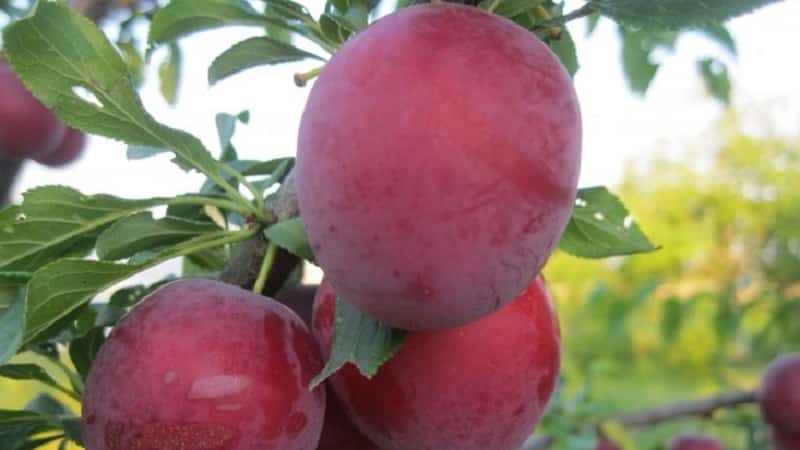
The fruits are oval-round, pointed, the tip is hard. The pulp is dark orange in color, tender, the taste is sweet and sour. Fruit weight is 20-40 g, color is burgundy. The medium-sized stone is difficult to separate from the pulp. The Vladimir comet is sun-loving, prefers chernozem, loamy or soddy-podzolic soils. Resistance to fungal and viral diseases is above average.
Mara
Self-fertile variety is universal in use - good in fresh, canned, dried form. Cherry plum jam is served with tea or added to pies and muffins. Mara is a mid-season variety, the tree is not tall, the crown is spreading and raised. The fruits ripen in early July and do not fall off until August.
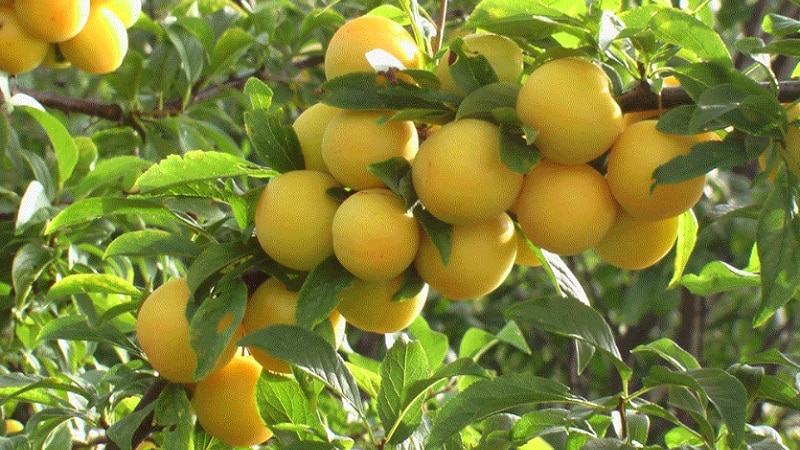
The shape of the fruit is flat-round, weight - about 22 g, color rich yellow, attractive. Due to its commercial qualities, the variety is also grown for sale. The pulp is very sweet and juicy, yellow in color. Winter hardiness and immunity to diseases are strong.
Interesting! In addition to jam and cherry plum jam, kvass, wine and the world-famous tkemali sauce are prepared. Its original taste goes harmoniously with fried meat. Cherry plum promotes the functioning of the digestive system and helps to digest the product faster.
Large
Large-fruited cherry plum varieties are a godsend for any summer resident. The weight of the fruit reaches 30-50 g. In order for them to grow large and juicy, it is recommended to pay attention to pruning and fertilizer. Cherry plum favorably responds to fertilizing with manure, ash, potassium and nitrogen.
Traveler
The variety is grown in the Moscow region and the southern regions of the country. The tree is of medium vigor, the crown is round and dense. Height - about 4 m, shoots are powerful.The leaves are light green, with slight pubescence.
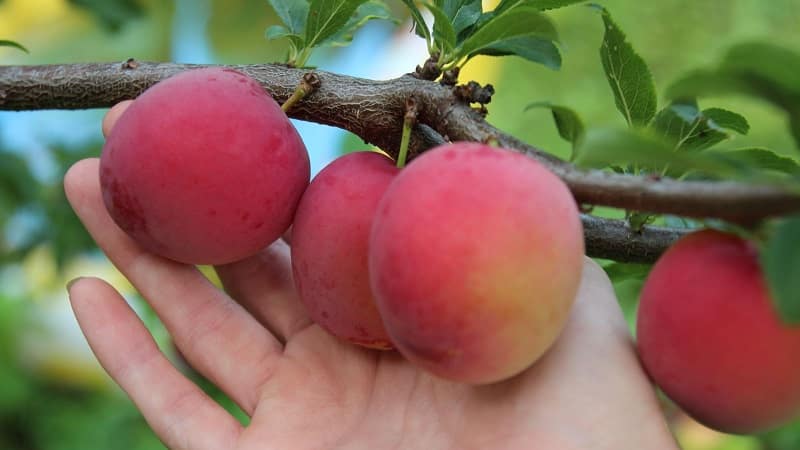
The fruits are round, weight - about 30 g, color red-violet. The pulp is orange, tender and soft, the taste is sweet and sour. The stone is medium, it is difficult to separate from the pulp. The fruits are suitable for canning and fresh consumption. Productivity - up to 40 kg per tree. Traveler is a partially self-fertile variety.
Cleopatra
The variety is partially self-fertile, with proper care it shows high yields.. The ripening period is average, the harvest is harvested in mid-late July. The trees are slightly spreading, the shoots are thin, the crown is sparse. Cleopatra begins to bear fruit in the fourth year after planting.
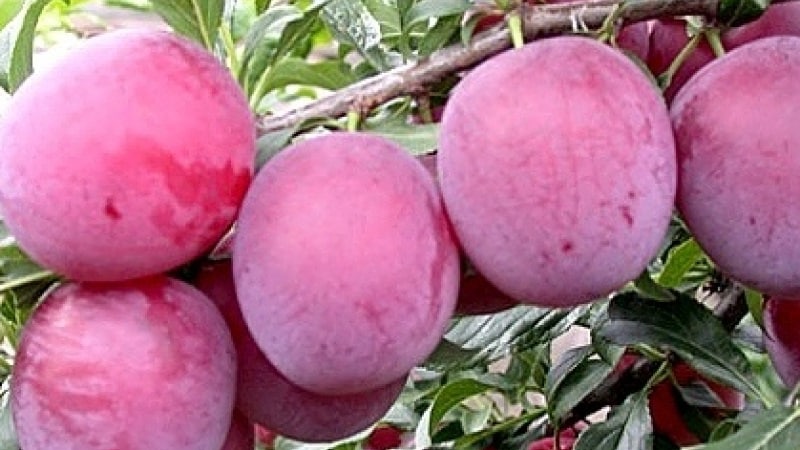
The fruits are dark purple, one-dimensional, average weight - 37 g. The flesh is gristly. The tasting rating of apricot-flavored cherry plum is 4.7 points. Cleopatra is distinguished by winter hardiness, attractive commercial qualities, and immunity to disease.
Interesting things on the site:
The best peach varieties for the Moscow region
short
Low-growing trees look original and neat and do not require a lot of free space. In terms of taste and commercial qualities, the fruits are not inferior to medium-sized and tall varieties. Let's consider the best self-fertile low-growing cherry plum varieties for the Moscow region.
Kuban comet
One of the most common varieties of cherry plum. Early ripening and high-yielding - up to 50 kg are harvested from one bush. Universal in use. Weight - 30-40 g, taste sweet and sour, ovoid shape.
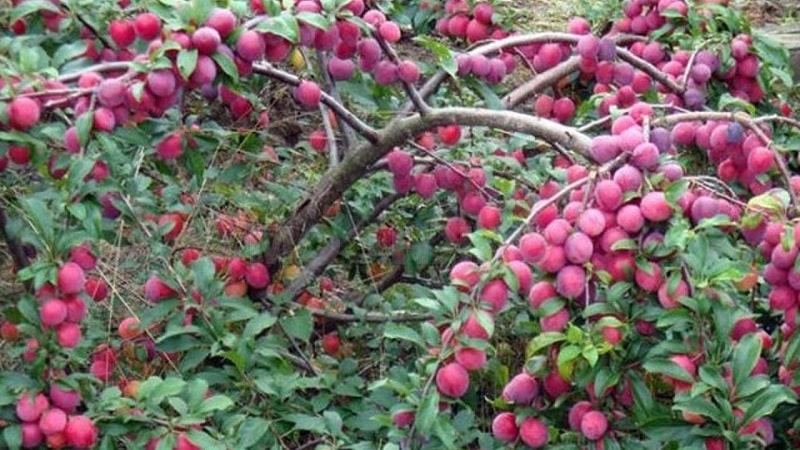
Burgundy color with a waxy coating, medium-length stalk. The pulp is fibrous and dense, yellow in color. The stone is small and does not separate from the pulp. The Kuban Comet cherry plum bears fruit 2-3 years after planting; the harvest is harvested in early July.A tree no more than 2.5 m high does not take up much space on the site.
Pearl
Hybrid cherry plum (seedling of Chinese plum Climex from free pollination by cherry plum). The culture is partially self-fertile. The height of the tree is 2.5-3 m, the crown is flat-rounded.
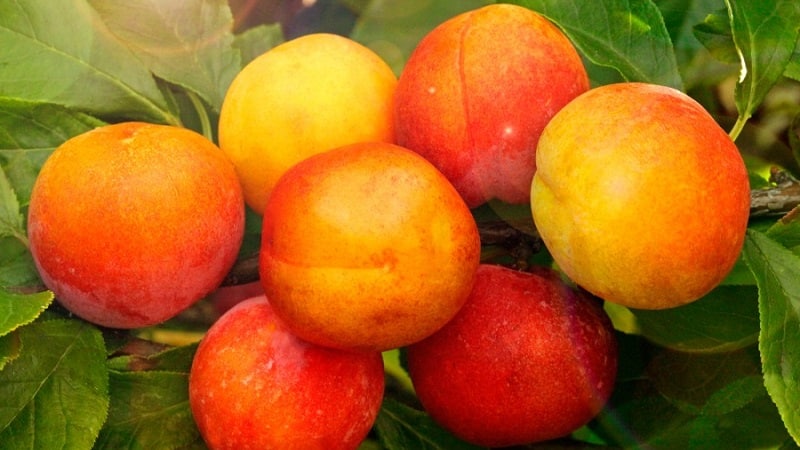
The fruits are ovoid-elongated and weigh about 30 g.. The pulp is dense, reddish, the taste is sweet and sour, the aroma is moderate. The ripening period is mid-early - the harvest is harvested in mid-July. Drought resistance and winter hardiness are average. There is immunity to moniliosis, but is affected by clasterosporiasis. Sweet juices and compotes, preserves and jams are prepared from Zhemchuzhina cherry plum.
An early variety of cherry plum from the Moscow region
Of the early varieties, summer residents distinguish the partially self-fertile cherry plum Karminnaya. The tree is medium-sized, the crown is rounded. The shoots are brown, the leaves are medium-sized, light green. The flowers are snow-white and small. Karminnaya ripens at the end of June.
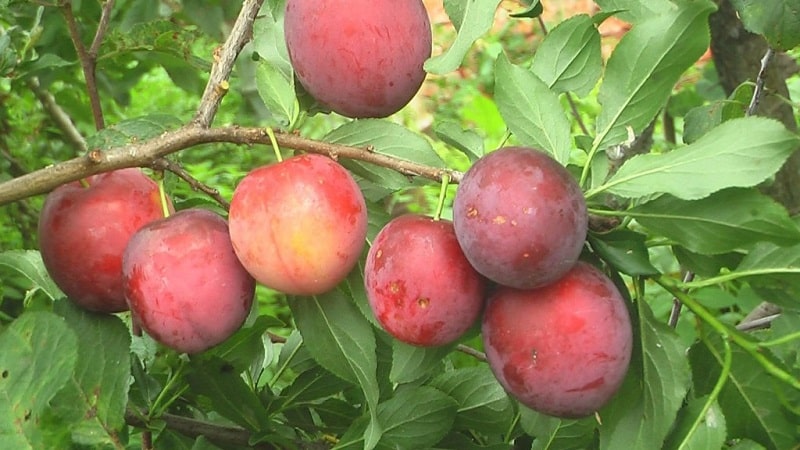
The fruits are round, weight - about 15 g, color dark red, original. The pulp is dense, the juice is colorless. The taste is sweet and sour, tasting score - 4.5 points. The oval bone is easily separated from the pulp.
Interesting! Cherry plums are pickled or dried in the sun. It makes a healthy and tasty addition to yogurt, cottage cheese, and milk porridge. Also, marmalade, pastille, confiture, puree or jelly are prepared from the sweet pulp of the fruit.
Late cherry plum
Late-ripening cherry plum variety Violet dessert ripens by the end of August. The tree is medium-sized, the crown is wide-pyramidal, and the density is average.
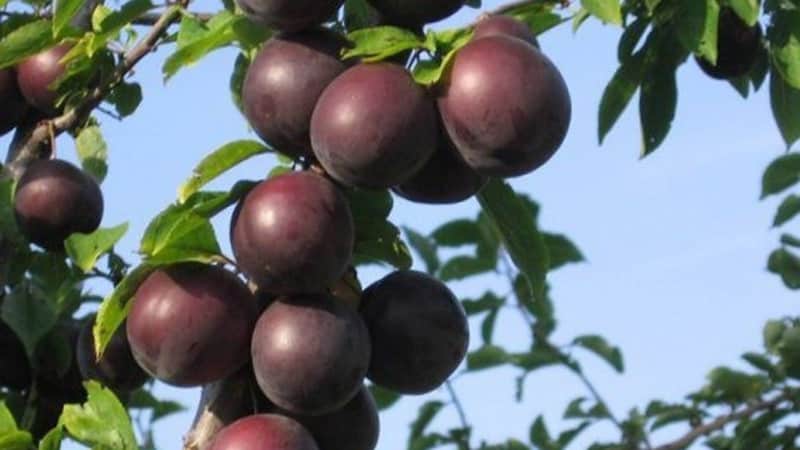
The fruits are large - the weight of one reaches 40 g, the shape is flat-round, the skin is dense. The color is burgundy with a thick waxy coating and yellow dots. The pulp is orange, dense and tender, sweet and sour. A small bone does not separate from the pulp. After ripening, the fruits do not fall off or crack.Purple dessert is resistant to moniliosis and insect pests. It is universal in application.
Read also:
Sweet cherries for the Moscow region and other regions of the Russian Federation
Growing cherry plum in the Moscow region
The yield of cherry plum depends on many factors - weather conditions, soil composition, proximity to other crops, and the application of mineral and organic fertilizers.
Planting in open ground
In the Moscow region, seedlings are planted in the spring. It is recommended to place the tree on the south side of the garden house - in a well-lit area, protected from winds and drafts. The depth of the hole is 0.5 m, the diameter is 1 m. The hole is filled with a mixture of soil, peat and nitrophoska. Before planting, the roots of the seedling are placed in a mash with the growth stimulator “Kornevin” - it strengthens the plant’s immunity and helps in the future to quickly adapt to climatic conditions.
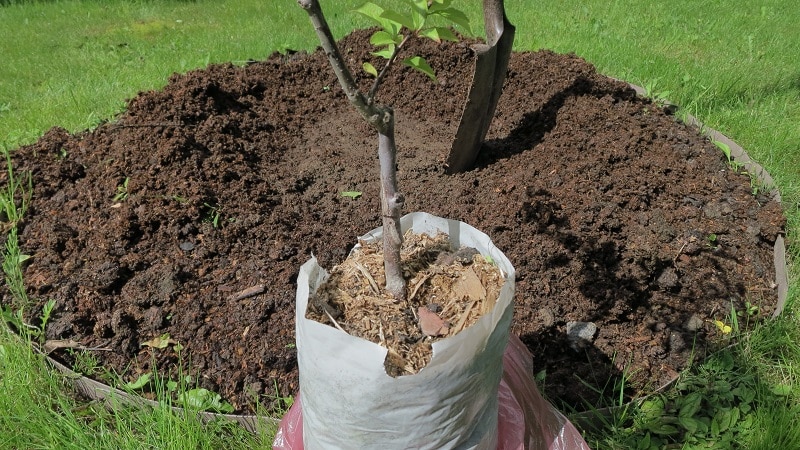
Seedlings are planted in calm weather. Place in a hole, cover with soil and mulch. Grass clippings, leaves, hay, sawdust or wood ash are used as mulch. For irrigation, take settled water at room temperature. If the variety is vigorous, drive two pegs along the edges of the hole. They perform the function of supporting the trunk. The seedling is tied to a support with strips of fabric, and small shoots are removed.
How to care
Before watering, dig a ditch around the tree. About 15 liters of water are used per tree. An adult cherry plum is watered three times during the summer, if there is heavy rain - twice. If a dry spring comes after winter, it is recommended to water the cherry plum in May. The time for watering is early morning or evening. Before moistening, gardeners loosen the soil so that the water penetrates deeper to the roots and does not evaporate from the surface.
Fertilize plantings annually. Organic fertilizers are applied to the tree trunk at the rate of 10 kg per 1 square meter. m. Before flowering, mineral fertilizers are added to the soil - nitrogen, potassium and phosphorus. For the winter, an adult cherry plum does not need shelter, and young seedlings are hilled up and mulched before the cold weather.
With the arrival of spring, the cherry plum is pruned. In March, sanitary pruning is carried out - old and diseased shoots are removed, and overgrowth is removed. In summer, dense shoots are removed using garden shears. In autumn, pruning is not carried out, since the procedure reduces the plant’s immunity before winter.
Attention! Early varieties ripen in late June - early July, mid-ripening varieties bear fruit throughout July, late-ripening varieties - from early August until the onset of autumn. Most varieties do not fall off, and after ripening they stay on the tree for 1-1.5 months.
Conclusion
To choose the appropriate cherry plum variety for the Moscow region, it is recommended to study the descriptions of the most popular ones and read reviews from experienced gardeners. Among the self-fertile varieties, the Kuban Comet, Zhemchuzhina, Traveler, and Vladimir Comet are popular. The plant is unpretentious in care; planting seedlings does not require special skills. Bright and sweet fruits are used in cooking, eaten fresh, canned and pickled. Self-fertile varieties are frost-resistant and high-yielding - one tree produces from 30 to 50 kg of fruit per season.